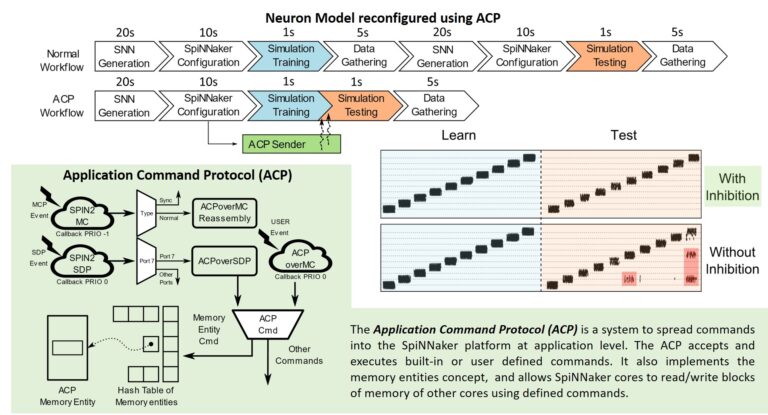Result description
One of the most relevant neuromorphic architecture is the SpiNNaker platform, a multi-core globally asynchronous locally synchronous board with a high scalability potential designed for running SNN simulations in real-time. The team of Prof Furber at the University of Manchester have developed this architecture which the first working piece was delivered to the community in 2012. From that year on, several teams have put a significant effort into the development of software tools for configuration, control and use of the board.
The Politecnico di Torino collaborates with the University of Manchester, within the HPB, for providing solutions to open problems of the SpiNNaker software stack. The two contributions delivered by the EDA-Group of PoliTo during HBP-SGA1 are the Resource allocation tools and a Flexible programming model framework that have been conceptualised and designed for exploiting the resources of the SpiNNaker and for facilitating its programming.
The Resource allocation tools have been delivered in the GrapH Optimizer SpiNNaker Tool (GHOST) module, which implements a new Partitioning and Placement methodology able to map Spiking Neural Network on parallel neuromorphic platforms. This methodology improves scalability/reliability of Spiking Neural Network (SNN) simulations on many-core and densely interconnected platforms. GHOST implements an SNN partitioning and placement (SNN-PP) algorithm for improving on-chip and off-chip communication efficiency.
Flexible programming model framework has been delivered in the Application Command Protocol (ACP) module which answers to the increasing demand for flexibility in terms of network configuration and runtime redesign of network parameters and simulated neurons models. ACP provides a mechanism to trigger the execution of high-level op-codes by the cores remotely and to manage their application memory for supporting a more flexible computational model and memory management.
Addressing target audiences and expressing needs
- We are sharing our knowledge
- Grants and Subsidies
- Incubators / Accelerators
- Collaboration
EDA Group of Politecnico di Torino is looking for partners involved in the Neuromorphic Engineering field, interested in the creation of new scientific proposals to be applied for funding.
- Others/ No specific audience
- Public or private funding institutions
- Other Actors who can help us fulfil our market potential
- Research and Technology Organisations
- Academia/ Universities
R&D, Technology and Innovation aspects
The research community and private companies have speed-up the development process of neuromorphic tools and alternative architectures. Thus for commercializing the neuromorphic technology in IoT products.
Result submitted to Horizon Results Platform by POLITECNICO DI TORINO

